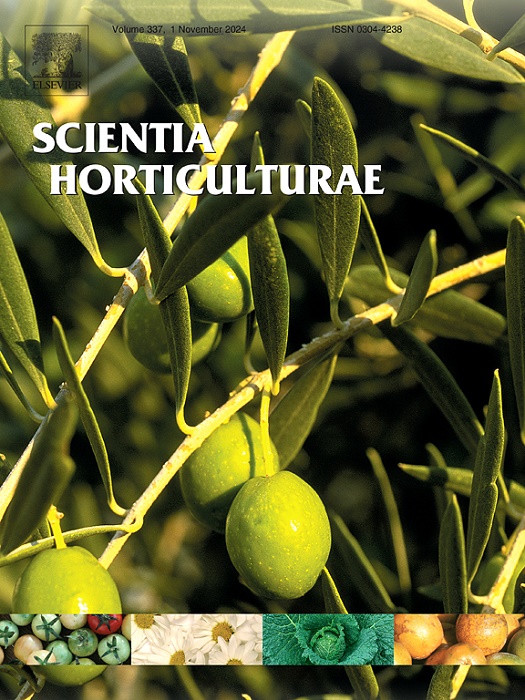Genome-wide identification and analyses of the AHL gene family in banana (Musa acuminata) and the functional analysis of MaAHL43 in fruit ripening
IF 3.9
2区 农林科学
Q1 HORTICULTURE
引用次数: 0
Abstract
Banana (Musa acuminata) is one of the most important and popular fruit crops worldwide. The AT-hook motif nuclear localized (AHL) is a conserved transcription factor family involved in the regulation of plant growth and development and stress response. However, the information of MaAHL genes remain largely elusive. In this study, a total of 48 MaAHL genes were identified based on Masu acuminata genome, which were distributed unevenly across 11 chromosomes. Phylogenetic analysis showed that the MaAHL proteins could be divided into two clades of A and B and subdivided into three types. The cis-regulatory elements in the promoter regions of MaAHL genes were mainly involved in diverse functions including plant growth and development, phytohormones responses, and stress response process. Expression profile analysis showed that MaAHL genes responded to osmotic stress and Fusarium oxysporum infection. In addition, the expression of clade-A MaAHL genes were generally downregulated while clade-B MaAHL genes were up-regulated during fruit ripening in banana. RT-qPCR showed that the expression of MaAHL43 gene was significantly up-regulated in middle and late stages of fruit ripening. MaAHL43 is located in nuclear and has no transactivation activity in yeast. Overexpression of MaAHL43 gene could promote banana fruit ripening, indicating MaAHL43 might a regulator of fruit ripening in banana. Taken together, this study would provide valuable information for further studies on the functions of MaAHL genes, and providing a new target for further research on the regulation network of banana fruit ripening.
香蕉AHL基因家族的全基因组鉴定与分析及MaAHL43在果实成熟中的功能分析
香蕉(Musa acuminata)是全球最重要、最受欢迎的水果作物之一。AT-钩基因核定位(AHL)是一个保守的转录因子家族,参与植物生长发育和胁迫反应的调控。然而,MaAHL 基因的信息在很大程度上仍然难以捉摸。本研究基于 Masu acuminata 基因组共鉴定出 48 个 MaAHL 基因,这些基因不均匀地分布在 11 条染色体上。系统发育分析表明,MaAHL蛋白可分为A和B两个支系,并细分为三种类型。MaAHL基因启动子区域的顺式调控元件主要涉及植物生长发育、植物激素反应和胁迫响应过程等多种功能。表达谱分析显示,MaAHL基因对渗透胁迫和镰孢菌感染有响应。此外,在香蕉果实成熟过程中,A族MaAHL基因的表达普遍下调,而B族MaAHL基因则上调。RT-qPCR 显示,MaAHL43 基因的表达在果实成熟的中后期显著上调。MaAHL43 位于核内,在酵母中没有转录活性。过表达 MaAHL43 基因可促进香蕉果实成熟,表明 MaAHL43 可能是香蕉果实成熟的调控因子。综上所述,本研究为进一步研究MaAHL基因的功能提供了有价值的信息,为进一步研究香蕉果实成熟的调控网络提供了新的目标。
本文章由计算机程序翻译,如有差异,请以英文原文为准。
求助全文
约1分钟内获得全文
求助全文
来源期刊

Scientia Horticulturae
农林科学-园艺
CiteScore
8.60
自引率
4.70%
发文量
796
审稿时长
47 days
期刊介绍:
Scientia Horticulturae is an international journal publishing research related to horticultural crops. Articles in the journal deal with open or protected production of vegetables, fruits, edible fungi and ornamentals under temperate, subtropical and tropical conditions. Papers in related areas (biochemistry, micropropagation, soil science, plant breeding, plant physiology, phytopathology, etc.) are considered, if they contain information of direct significance to horticulture. Papers on the technical aspects of horticulture (engineering, crop processing, storage, transport etc.) are accepted for publication only if they relate directly to the living product. In the case of plantation crops, those yielding a product that may be used fresh (e.g. tropical vegetables, citrus, bananas, and other fruits) will be considered, while those papers describing the processing of the product (e.g. rubber, tobacco, and quinine) will not. The scope of the journal includes all horticultural crops but does not include speciality crops such as, medicinal crops or forestry crops, such as bamboo. Basic molecular studies without any direct application in horticulture will not be considered for this journal.
 求助内容:
求助内容: 应助结果提醒方式:
应助结果提醒方式:


